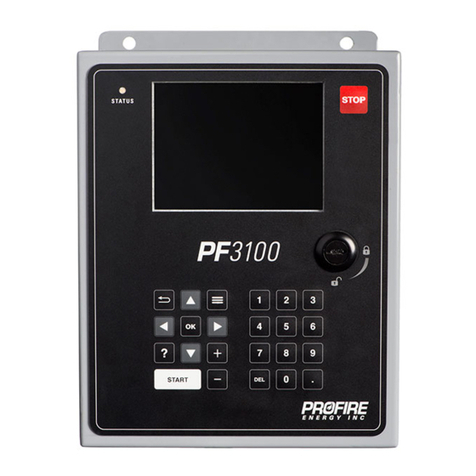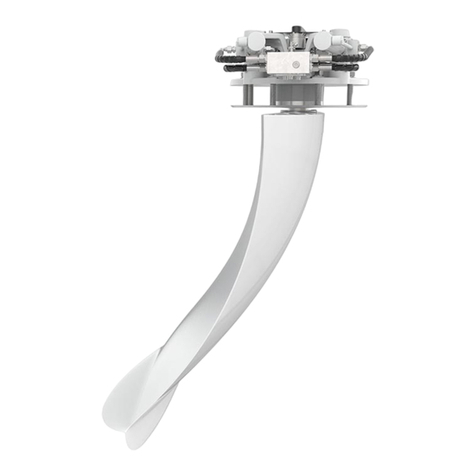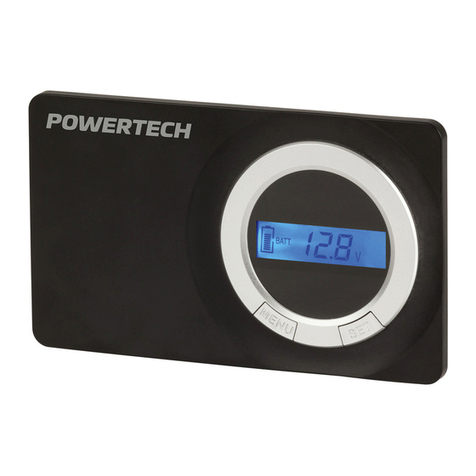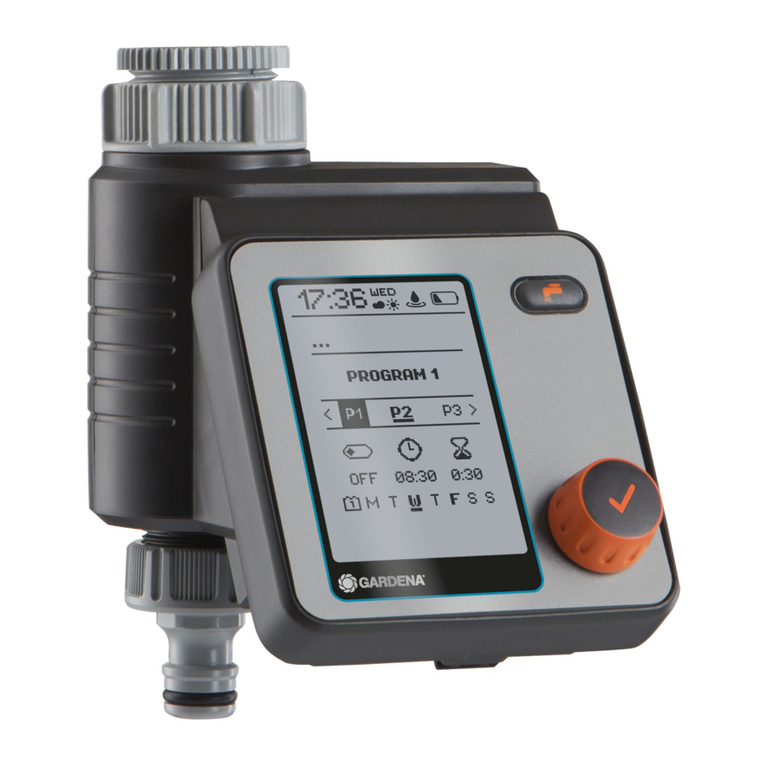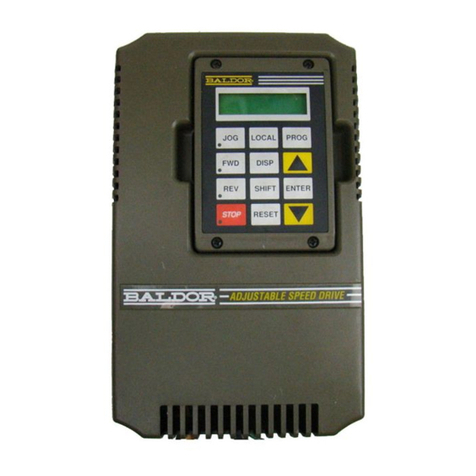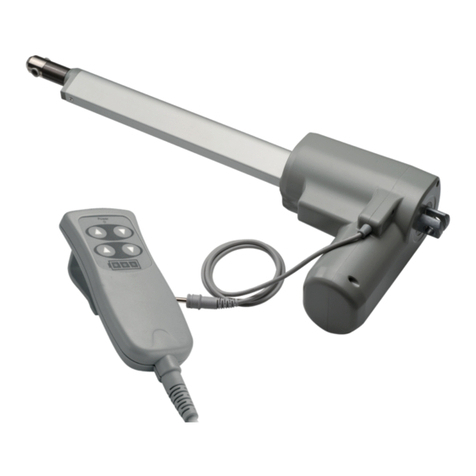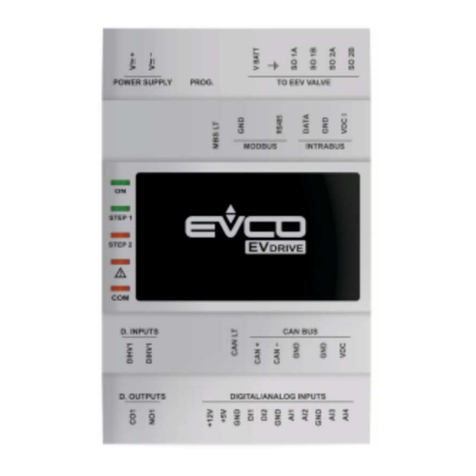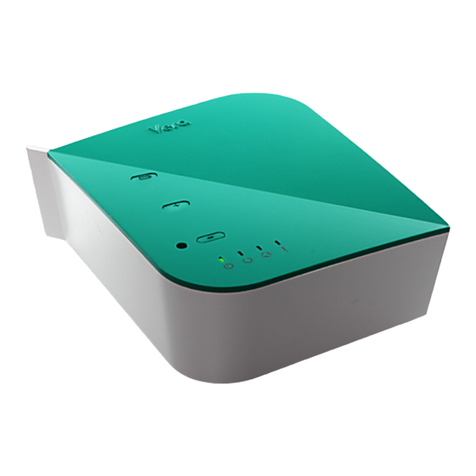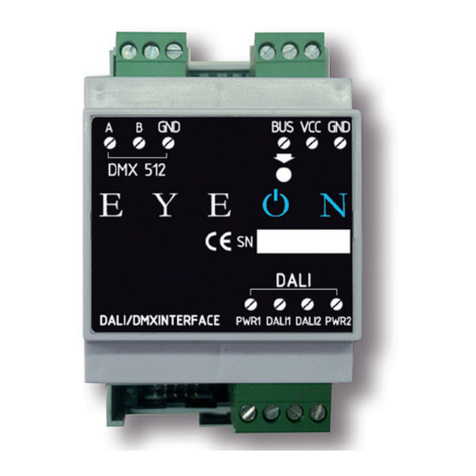Profire Energy PF2200-SB User manual

DOC-001043 / v5.2
PF2200-SB
PRODUCT MANUAL

DOC-001043 / v5.2
2
PROPRIETARY INFORMATION: THIS DOCUMENT IS PREPARED BY PROFIRE ENERGY FOR THE USE OF OUR CUSTOMER. PROFIRE ENERGY ASSUMES NO LIABILITY TO
ANY OTHER PARTY FOR ANY REPRESENTATIONS CONTAINED HEREIN.
TABLE of CONTENTS
1INTRODUCTION .......................................................................................................................................................... 4
1.1 SCOPE AND PURPOSE............................................................................................................................................................................4
1.2 TERMS AND ABBREVIATIONS..............................................................................................................................................................5
1.3 ACRONYMS .............................................................................................................................................................................................7
1.4 PRODUCT SUPPORT..............................................................................................................................................................................8
1.5 RELATED LITERATURE...........................................................................................................................................................................8
1.6 REFERENCE STANDARDS ....................................................................................................................................................................8
2PF2200-SB PRODUCT DESCRIPTION......................................................................................................................... 9
2.1 PRODUCT OVERVIEW...........................................................................................................................................................................9
2.1.1 USER INTERFACE CARD ................................................................................................................................................................10
2.1.2 BMS CARD.........................................................................................................................................................................................11
2.1.3 KEYPAD ..............................................................................................................................................................................................25
2.1.4 ENCLOSURE......................................................................................................................................................................................26
2.2 OPERATING SEQUENCE.....................................................................................................................................................................28
2.2.1 POWER ON .......................................................................................................................................................................................29
2.2.2 LOCKOUT ..........................................................................................................................................................................................29
2.2.3 READY.................................................................................................................................................................................................30
2.2.4 ALARM ................................................................................................................................................................................................30
2.2.5 WAITING............................................................................................................................................................................................31
2.2.6 IGNITION...........................................................................................................................................................................................31
2.2.7 PILOT...................................................................................................................................................................................................32
2.2.8 MAIN LIGHT OFF.............................................................................................................................................................................33
2.2.9 PROCESS CONTROL.......................................................................................................................................................................34
2.3 GENERAL REQURIEMENTS................................................................................................................................................................37
2.3.1 PF2200 DECLARATIONS................................................................................................................................................................37
2.4 CERTIFICATION AND APPROVALS ...................................................................................................................................................38
3INSTALLATION AND COMMISSIONING .................................................................................................................39
3.1 SYSTEM CONFIGURATION................................................................................................................................................................39
3.1.1 PASSWORDS.....................................................................................................................................................................................39
3.1.2 INTERFACING...................................................................................................................................................................................40
3.1.3 ELECTRICAL and MECHANICAL RATINGS................................................................................................................................43
3.2 IMPORTANT SAFETY INFORMATION ............................................................................................................................................47
3.2.1 GENERAL WARNINGS....................................................................................................................................................................47
3.2.2 EXPLOSION HAZARD WARNINGS.............................................................................................................................................47
3.2.3 INSTALLATION WARNINGS .........................................................................................................................................................48
3.3 MOUNTING CONSIDERATIONS......................................................................................................................................................49

DOC-001043 / v5.2
3
3.3.1 ORIENTATION & LOCATION.......................................................................................................................................................49
3.3.2 MOUNTING CARDS........................................................................................................................................................................50
3.3.3 PROTECTIVE EARTHING................................................................................................................................................................51
3.3.4 ELECTRICAL NOISE .........................................................................................................................................................................51
4OPERATIONS AND MAINTENANCE ........................................................................................................................52
4.1 ASSUMPTIONS SPECIFIC TO USE.....................................................................................................................................................52
4.2 TRANSPORTATION &STORAGE CONDITIONS..........................................................................................................................52
4.3 OPERATOR USER INTERFACE...........................................................................................................................................................53
4.3.1 STATUS SCREEN...............................................................................................................................................................................53
4.3.2 SETTINGS SCREEN...........................................................................................................................................................................53
4.3.3 SETTINGS DESCRIPTIONS.............................................................................................................................................................57
4.3.4 SYSTEM SCREEN ..............................................................................................................................................................................69
5TROUBLESHOOTING.................................................................................................................................................76
6MAINTENANCE ......................................................................................................................................................... 78
6.1 REPAIR AND REPLACEMENT ..............................................................................................................................................................79
6.2 DECOMMISSIONING ..........................................................................................................................................................................79
6.3 USEFUL LIFE ...........................................................................................................................................................................................79
6.4 MANUFACTURER NOTIFICATION...................................................................................................................................................79
7DOCUMENT REVISION HISTORY.............................................................................................................................81
8APPENDIX A: ALARM CODES & RESPONSE TIMES................................................................................................83
9APPENDIX B: FUNCTIONAL SAFETY DESIGN PF2200-SB ...................................................................................... 89
9.1 SAFETY VS NON-SAFETY I/O.............................................................................................................................................................91
9.2 SAFETY FUNCTIONS............................................................................................................................................................................92
9.3 SAFETY INTEGRITY...............................................................................................................................................................................93
9.3.1 SYSTEMATIC CAPABILITY..............................................................................................................................................................93
9.3.2 RANDOM CAPABILITY ...................................................................................................................................................................93
9.3.3 RATE of DEMAND............................................................................................................................................................................93
9.3.4 HARDWARE VERSIONS..................................................................................................................................................................94
9.3.5 SOFTWARE VERSIONS ...................................................................................................................................................................94
9.3.6 SAFETY PARAMETERS.....................................................................................................................................................................94
9.3.7 SUGGESTED PROOF TEST.............................................................................................................................................................97
9.3.8 DIAGNOSTIC TEST INTERVAL......................................................................................................................................................97

DOC-001043 / v5.2
4
1INTRODUCTION
1.1 SCOPE and PURPOSE
This document is intended to be a full description and the intended use of the PF2200-SB product in
accordance with the product life cycle. This document outlines the following:
•PF2200-SB Product Description: this section describes the intended use of the product; including I/O,
operating sequence, general requirements and approvals
•Installation and Commissioning: this section describes the actions needed to perform installation and
commissioning of the PF2200-SB; including electrical/mechanical ratings, configuration parameters,
mounting considerations and warnings
•Operations and Maintenance: this section describes the actions needed for ongoing operation and
maintenance of the PF2200-SB; including troubleshooting, maintenance, repair and replacement,
decommissioning and manufacturer notification

DOC-001043 / v5.2
5
1.2 TERMS and ABBREVIATIONS
1oo1
One out of one deployment configuration.
Alarm
An indication of an abnormal condition in either the equipment or the process.
Continuous Pilot
A pilot which, once placed in operation, is intended to remain ignited continuously until it is manually
interrupted
Digital Input
An input to the system that can be one of only two states (Energized or De-energized).
Electronic
Disconnection
Non-cycling interruption by an electronic device of a circuit for functional disconnection which
provides a disconnection other than by means of an air gap by satisfying certain electrical
requirements in at least one pole
Flame Detector
Device which provides the programming unit with a signal indicating the presence of absence of flame
Flame Detector
Response Time
Period of time between loss of the sensed flame and the signal indicating the absence of flame
Flame Detector Self-
Checking Rate
Frequency of self-checking function of the flame detector (in number of operations per unit of time)
Flame Failure Lock-out
Time
Period of time between the signal indicating absence of flame and lock-out
Full Rate Start
Condition in which the main burner ignition and subsequent flame supervision occur at full fuel rate
Ignition Time
Period of time during which the ignition device is energized
Incorporated Control
Control intended for incorporation in, or on, an equipment, but which can be tested separately.
Intermittent Pilot
A pilot which is automatically ignited when an appliance is called on to operate and which remains
continuously ignited during each period of main burner operation. The pilot is automatically
extinguished when each main burner operating cycle is completed
Interrupted Ignition
A type of ignition which is energized prior to the admission of fuel to the main burner and which is
de-energized when the main flame is established
Interrupted Pilot
A pilot which is automatically ignited prior to the admission of fuel to the main burner and which is
automatically extinguished when the main flame is established
Lockout
A state in which all powered outputs (Valves and Ignition) are de-energized and interaction from the
user is required in order to exit the state.
Low Rate Start
Condition in which main burner ignition occurs at low fuel rate. Once ignition at low fuel rate occurs
and the flame is proven, full main burner fuel rate may be admitted
Main Permissive
An event which causes the BMS to de-energize the main solenoid outputs (SSV) and remain in that
state until the event clears (or an alarm / wait condition forces the BMS out)
Maximum Flame-failure
Re-ignition Time
Period of time between the signal indicating absence of flame and the signal to energize the ignition
device. During this time period the fuel supply is not shut off.

DOC-001043 / v5.2
6
Non-volatile Lockout
Condition such that a restart can only be accomplished by a manual reset of the system and by no
other cause
Permanent Operation
System which is intended to remain in the running position for longer than 24 h without interruption
Pilot-flame Establishing
Period
Period of time between the signal to energize the pilot fuel flow means and the signal indicating
presence of the pilot flame
Post-Ignition Time
Period of time between the signal indicating presence of flame and the signal to de-energize the
ignition device
Post-Purge Time
Purge time that takes place immediately following the shutting off of the fuel supply
Pre-Ignition Time
Period of the ignition time between the signal to ignite and the signal to energize the fuel flow means
Pre-Purge Time
Purge time that takes place between initiation of a burner control sequence and the admission of fuel
to the burner
Recycle Time
Period of time between the signal to de-energize the fuel flow means following the loss of flame and
the signal to begin a new start-up procedure
Safety Output
A powered electrical output from the PF2200 BMS card designed to control safety actuators (e.g.
safety shut off valves, ignition coils, etc.). Safety Outputs of the PF2200 BMS card are as follows: Pilot
1, Pilot 2, SSV, High Fire, Coil 1, and Coil 2.
Safety-interlock
A term used to describe an input (either switch or Transmitter) that must be satisfied to run. If the
interlock is not satisfied (e.g. open switch or out of range transmitter) the system will proceed to lock-
out.
Shutdown
The process the system goes through when it receives an alarm event while running. This is
immediately followed by entering the state of Lockout.
Signal for Absence of
Flame
Maximum signal which indicates the loss of flame
Signal for Presence of
Flame
Minimum signal which indicates the presence of flame when there was previously no flame
Start-up Lock-out Time
Period of time between the signal to energize the fuel flow means and lock-out
Type 2 Action
Automatic action for which the manufacturing deviation and the drift of its operating value, operating
time, or operating sequence have been declared and tested under the IEC 60730 standard.
Wait
An event which causes the BMS to proceed to a state which will de-energize all safety outputs. When
all wait events clear, the BMS is free to automatically recycle.
Waiting Time
Period between the start signal and the signal to energize the ignition device. For burners without
fans, natural ventilation of the combustion chamber and the flue passages normally takes place during
this time.

DOC-001043 / v5.2
7
1.3 ACRONYMS
BMS Burner Management System
ESD Emergency Shut Down –a mechanism that shuts down the system in the event of a
safety emergency
FIT Failure In Time (unit) –represents the number of failures occurring in 109hours
FMEDA Failure Mode, Effects and Diagnostic Analysis
HFT Hardware Fault Tolerance
HFV High Fire Valve
I/O Generic name for a terminal that can be an input, output, or a combination or both.
PFDAVG Average Probability of Failure on Demand
PF2200-SB Model number for the PF2200 Single Burner BMS product. Consists of: BMS Card,
User Interface Card, keypad, enclosure and ignition switch
PFN Profire Network. Method of communication between User Interface Card and BMS
Card.
PTC Proof Test Coverage
PWM Pulse Width Modulation
RTD Resistive Thermal Device
SIL Safety Integrity Level. A discrete level (one out of a possible four) for specifying the
safety integrity requirements of the safety functions to be allocated to the E/E/PE
safety-related systems where Safety Integrity Level 4 has the highest level of safety
integrity and Safety Integrity Level 1 has the lowest
SIF Safety Instrumented Function. A set of equipment intended to reduce the risk
due to a specific hazard (a safety loop)
SFF Safe Failure Fraction. The fraction of the overall failure rate of a device that results
in either a safe fault or a diagnosed unsafe fault
SSV Safety shutoff valve. A valve that shuts off for safety reasons.
TCV Temperature Control Valve

DOC-001043 / v5.2
8
1.4 PRODUCT SUPPORT
Product support can be obtained from:
Profire Energy
1.855.776.3473
321 South, 1250 West Suite 1
Lindon, UT 84042, USA
1.5 RELATED LITERATURE
PF2200 Single Burner BMS –Modbus Registers
PF2200 Single Burner BMS –Software Release Notes
1.6 REFERENCE STANDARDS
IEC 61508:2010 Functional Safety of Electrical / Electronic / Programmable Electronic Safety-Related Systems
CSA 22.2 No. 60730-2-5 / ANSI Z21.20:14
UL 60730-2-5
CSA 22.2 No. 213-17
UL 121201. ED9

DOC-001043 / v5.2
9
2PF2200-SB PRODUCT DESCRIPTION
2.1 PRODUCT OVERVIEW
The PF2200 Single Burner Controller (PF2200-SB) product is designed to provide safe and reliable control
over industrial heating appliances. This product consists of four main pieces:
•User Interface Card: the card which provides interaction to the user / operator. This card monitors
user input and displays all relevant status / setting information to the user.
•BMS Card: the “safety brain” of the product. This card stores all the relevant safety information and
performs the operating sequence in accordance with the timings in the safety settings.
•Keypad: allows the user / operator to interact with the product through a series of buttons.
•Enclosure: provides protection for the product against environmental conditions.

DOC-001043 / v5.2
10
2.1.1 USER INTERFACE CARD
The User Interface Card allows interaction with the system through the use of the keypad and a display. This
card interacts with the BMS card through a proprietary communication protocol, called PFN, which utilizes
the RS-485 physical transport layer. PFN and power to the User Interface are factory wired to the BMS card
through a wiring harness.
2.1.1.1 MODBUS
Remote access to status information and non-safety critical settings can be achieved via the Modbus port of
the User Interface card. The Modbus port supports Modbus RTU over the RS-485 physical layer. For a
complete register list, see PF2200 Single Burner BMS –Modbus Registers. By design, safety critical settings
are not accessible via Modbus.
2.1.1.2 USB
The USB port of the User Interface Card is used for data-logging, settings backup and restore and updating
firmware. Data-logging is enabled by going to the Firmware Update screen on the User Interface and is
limited by the size of USB stick-- a USB stick of size 1GB or larger is recommended. Firmware update is only
supported using authorized firmware bundles. Contact Profire Energy for an authorized firmware bundle.
2.1.1.3 STATUS LED
The User Interface Card has a tricolor Status LED which is visible on the front panel of the product. The states
of the Status LED are defined below:
State
LED Behavior
System is not running and is in lockout
Fast Blink Red
System is not running and has an alarm
Blink Red
System is not running
Solid Red
System is running –no warnings or waits present
Solid Green
System is running –in wait state
Blink Green
System is running –in wait state with a warning
present
Blink Amber
System is running –with a warning present
Solid Amber

DOC-001043 / v5.2
11
2.1.2 BMS CARD
The BMS card provides the necessary I/O and functionality to reliably and safely control a burner. In addition,
the BMS card also has tertiary features that are not safety rated but provide a functional benefit to the overall
product.

DOC-001043 / v5.2
12
2.1.2.1 PILOT VALVE OUTPUTS (Pilot 1 and Pilot 2)
Two powered outputs (terminals 15-16 and 17-18) are intended to be connected to solenoid valves which
control the fuel line for the pilot. When Pilot 2 is enabled, both outputs work in conjunction with one another
meaning that they energize and de-energize in unison. If Pilot 2 is disabled, the Pilot 2 output will stay de-
energized. The Pilot Outputs are capable of PWM output mode at a fixed 3 kHz frequency. Supported duty
cycles for PWM mode are 10-100% and are configurable via the user interface.
2.1.2.2 MAIN VALVE OUTPUTS (SSV)
Two powered outputs (terminals 19-20 and 21-22) are intended to be connected to solenoid valves which
control the main fuel line for the burner. Both outputs work in conjunction with one another meaning that
they energize and de-energize in unison. The Main Valve Outputs are capable of PWM output mode at a
fixed 3 kHz frequency. Supported duty cycles for PWM mode are 10-100% and are configurable via the user
interface.
2.1.2.3 IGNITION OUTPUTS (Coil +/-)
Two powered outputs (terminals 55-56 and 59-60) are intended to be connected to an ignition source (e.g.
ignition transformer). When Pilot 2 is enabled, both outputs work in conjunction with one another meaning
they energize and de-energize in unison. If Pilot 2 is disabled, the Pilot 2 Coil output will stay de-energized.
Two ignition modes are supported by the system and configurable via the user interface: Coil Mode and High
Energy Ignition (HEI) mode. Coil mode sends a pulsed signal of fixed frequency and duty cycle and is
intended to be used in conjunction with an ignition transformer. In HEI mode, the output is energized with a
steady state DC voltage that can be used to enable an external High Energy Ignition source.
2.1.2.4 FLAME DETECTION I/O (Ion +/-)
Two Ionization flame detection I/O (terminals 53-54 and 57-58) are supported by the PF2200-SB. These
terminals are intended to be connected to a flame rod which makes physical contact with the flame.
Through the use of the rectification property of the flame, the PF2200-SB measures the presence of flame by
applying an AC signal to the rod. If an open circuit event exists, the result will be a loss of flame.
Pilot 1 flame detection is always enabled, whereas Pilot 2 flame detection can be enabled or disabled via the
user interface. If Pilot 2 flame detection is enabled, both Pilot 1 and Pilot 2 flames must be established and
present in order for the system to continue to run.
2.1.2.5 HIGH FIRE VALVE (HFV) OUTPUT
One powered output (terminals 23 and 24) is intended to be connected to a solenoid valve when a staged
heating appliance is needed. In this application, the high fire valve output is intended to be the highest level

DOC-001043 / v5.2
13
of heat demand (Stage 2). If a lower level of heat demand is needed, the high fire valve will be de-energized
while the Main Valve Outputs (SSV) remain energized (Stage 1).
2.1.2.6 START/STOP SWITCH
The external Start/Stop switch can be used to start, stop or clear a lockout on the system. The various
positions / actions are outlined in the table below:
Switch State
Behavior
Switch State Mode
Stop
Hold the system in lockout
ESD or Shutdown
Run
Transition to a ready state or maintain a running
state.
Ready
Ignite
If held for 1 second or more, transition into the
Confirm Start state.
System Start
Run -> Stop -> Run
Acknowledge and clear lockout condition
N/A
Note: if switch is held in the Ignite state for longer than 5 seconds, the system will alarm.
2.1.2.7 EMERGENCY SHUTDOWN (ESD) INPUT
The ESD input (terminals 33-34) is an energized-to-run digital input that is always enabled. If the contact is
de-energized, the system will present an alarm and proceed to lockout (if running). If the contact is
energized, the alarm will clear.

DOC-001043 / v5.2
14
2.1.2.8 PRESSURE INPUT
The Pressure input (terminals 5-6) is meant to monitor an external pressure (e.g. fuel pressure) and provide
the necessary feedback in the event of a high and/or low pressure event. Configurable as disabled, digital
input or 4-20mA signal through the user interface; the pressure input can be connected to either a switch or
transmitter.
In digital input mode, the input can be configured as either an Alarm, Wait, Warning or Main Permissive when
the contact opens. This is intended to be connected to a low pressure switch.
In 4-20mA mode, a high pressure trip event will cause an alarm and a low pressure trip event can be
configured as an Alarm, Wait, Warning or Main Permissive; if the event persists after the mains have opened.
This mode is intended for use with a pressure transmitter.
The following table outlines the behavior of the Pressure Input:
Input
Configuration
Event
System Behavior
Disabled
Any
No Effect
Digital Input
De-energized with low pressure mode set to Wait
Wait
De-energized with low pressure mode set to Alarm
Alarm
De-energized with low pressure mode set to Main
Permissive
Main Permissive
De-energized with low pressure mode set to Warning
Warning
Energized
Run
4-20mA
Out of range
Alarm
Low trip with low pressure mode set to Alarm
Alarm
Low trip with low pressure mode set to Wait
Wait
Low trip with low pressure mode set to Main Permissive
Main Permissive
Low trip with low pressure mode set to Warning
Warning
Active range
Run
High trip with mains ON
Alarm
High trip with mains OFF
Run

DOC-001043 / v5.2
15
2.1.2.9 LEVEL INPUT
The Level input (terminals 41-42) is meant to monitor an external level or flow measurement and provide the
necessary feedback in the event of a high and/or low level/flow event. Configurable as disabled, digital input
or 4-20mA signal through the user interface; the level input can be connected to either a switch or
transmitter.
In digital mode the level input can be used a Wait, Warning or Alarm when the contact opens. This can be
connected to a low or high trip switch depending on the application.
In 4-20mA mode the level input is used in conjunction with the low-trip and high-trip modes. These modes
are independent of one another and can be configured as a Wait, Warning or Alarm. This input is intended
to be connected to a level or flow transmitter.
The following table outlines the behavior of the Level Input:
Input
Configuration
Event
System Behavior
Disabled
Any
No Effect
Digital Input
De-energized with digital mode set to wait
Wait
De-energized with digital mode set to warning
Warning
De-energized with digital mode set to alarm
Alarm
Energized
Run
4-20mA
Out of range
Alarm
Low trip with low trip mode set to wait
Wait
Low trip with low trip mode set to warning
Warning
Low trip with low trip mode set to alarm
Alarm
Active range
Run
High trip with high trip mode set to wait
Wait
High trip with high trip mode set to warning
Warning
High trip with high trip mode set to alarm
Alarm

DOC-001043 / v5.2
16
2.1.2.10 TEMPERATURE INPUTS
The PF2200-SB has three distinct temperature inputs: Bath, Outlet and Stack; each of which are configurable
to be either a Type-K thermocouple or PT-100 RTD input.
Each of the three distinct temperature inputs mentioned above have the following set points that can be
configured via the user interface (note: depending on the mode, the temperature input may or may not
utilize all the set points below; see Temperature Mode for more details):
•High Temperature ESD Setpoint: temperature at which the system shuts down. If the temperature
input exceeds this trip point, the system will generate an alarm and if running proceed to lockout
•Pilot Off Setpoint: temperature at which the system de-energizes all valves, including the pilot, and
enters a waiting state. When the temperature falls back down below this value minus the deadband,
the system will reignite the pilot.
•Main Off Setpoint: temperature at which the system de-energizes the main valves and enters the
Pilot state. The main valves will be turned back on when the temperature drops below the Process
Control Setpoint minus the deadband.
•Process Control Setpoint: The setpoint about which the process temperature will be controlled. In
PID mode, the TCV will be actuated in relation to this setpoint. In Staged Heating mode, the HFV will
be actuated about this setpoint.
•Low Temperature Warning Setpoint: If the temperature drops below this trip point the system will
display a warning on the user interface and will continue to run.
The three temperature inputs listed above also have a user-configurable mode. The various temperature
modes are defined below:
•Disabled: Temperature input is ignored.
•High Temp ESD: Temperature input is monitored for High Temp ESD event only. Setpoints used in
this mode: High Temperature ESD and Low Temperature Warning
•Process Control Mode: Temperature input is monitored for High Temp ESD event as well as used for
process control. Setpoints used in this mode: High Temperature ESD, Pilot Off, Main Off, Process
Control and Low Temperature Warning Setpoint.
•Display Only: Temperature inputs are read in and displayed on the User Interface. The system does
NOT act on this information in any way. Setpoints used in this mode: none.

DOC-001043 / v5.2
17
Input
Terminals
Type
Modes Supported
Bath
61-66
Dual Element with cross comparison
Single Element
High Temp ESD
Process Control
Outlet
67-69
Single Element
Disabled
High Temp ESD
Process Control
Display Only
Stack
70-72
Single Element
Disabled
High Temp ESD
Display Only
2.1.2.11 PROOF of CLOSURE (PoC) INPUT
The Proof of Closure input (terminals 11-12) is a digital input meant to be connected to a Proof of Closure
switch, indicating the closure of the main valve(s). An energized Proof of Closure input indicates that the
main valve is closed. The PF2200-SB monitors the Proof of Closure input and takes action, as outlined in the
table below.
Input
Configuration
Event
System Behavior
Disabled
Any
No Effect
Digital Input
De-energized with main off
Alarm
De-energized with main on
Run
Energized
Run

DOC-001043 / v5.2
18
2.1.2.12 REMOTE START INPUT
The Remote Start input (terminals 35-36) is a digital input intended to provide the ability to start the system
from an external source (e.g. a switch or PLC). The remote start input is an energized-to-run input, meaning
that if the contact is de-energized the system will proceed to a WAIT state. A toggle of the start input from
the energized to de-energized to energized position causes the system to either clear a lockout (if one is
present) or start the system (if there are no alarms). This means that if a lockout is present and the operator
wishes to start the system, two toggles of the start contact is necessary (one to clear the lockout, and the
other to start the system). This functionality is outlined in the table below.
Input
Configuration
Event
System Behavior
Disabled
Any
No Effect
Digital Input
De-energized and system is in a running state
Wait
De-energized and system is not running
No Effect
Transition from energized to de-energize to energized
Acknowledge lockout if
present, start if no alarm
present
Energized
Run
2.1.2.13 HIGH PRESSURE INPUT
The High Pressure input (terminals 7-8) is a digital input intended to be connected to a high pressure switch.
This contact is energized to run, meaning that a de-energized contact indicates a high pressure event. The
high pressure functionality is outlined in the table below.
Input
Configuration
Event
System Behavior
Disabled
Any
No Effect
Enabled
De-energized
Alarm
Energized
Run

DOC-001043 / v5.2
19
2.1.2.14 PROOF of MAIN LIGHT OFF (POL) INPUT
The Proof of Main Light Off input (terminals 9-10) is intended to be used in conjunction with either a TCV
capable of position feedback or a High Fire valve with light-off position indication. Capable of both 4-20mA
and Digital modes, the Proof of Main Light Off input gives the system the ability to prove a light off position
before opening the main gas valves.
In digital mode this input is intended to connect to a proof of closure switch on the HFV OR with a proof of
position switch on a TCV. In 4-20mA mode this input is intended to connect to a TCV that has positional
feedback. When in 4-20mA mode, the system will monitor the position input and cross-check with the user-
defined setpoint & tolerance fields. In either mode the input is monitored only during the transition from
pilot to main in the request light off sequence. If the contact is not proven within 60 seconds the system will
lockout.
Mechanically, the light off position proving requires a proof of closure valve for the HFV if the system is
utilizing staged heating control or in PID control mode a position switch / 4-20mA position feedback signal
from the TCV.
The following table outlines the functionality of the input.
Input
Configuration
Event
System Behavior
Disabled
Any
No Effect
Digital Input
De-energized during pilot to main transition (60s
elapsed)
Alarm
Energized during pilot to main transition
System transitions to main
De-energized or Energized in all other states
No Effect
4-20mA Input
Out of range
Alarm
Low trip or High Trip during pilot to main transition (60s
elapsed)
Alarm
Low trip, Active Range, or High Trip during all other
states
No Effect
Active range during pilot to main transition
System transitions to main

DOC-001043 / v5.2
20
2.1.2.15 AUXILIARY TEMPERATURE INPUT
The Auxiliary Temperature Input (terminals 43-44) is intended to be connected to a temperature sensor with
a 4-20mA interface. This 4-20mA input can be mapped to a temperature using the span settings (Max and
Min) and can be configured as: Disabled, High Temp ESD, Process Control, or Display Only. For details on the
individual modes and setpoints, see the Temperature Inputs section of this document.
2.1.2.16 AUXILIARY INPUT
The Auxiliary Inputs 1 and 2 (terminals 45-46 and terminals 47-48 respectively) are intended to be connected
to a generic I/O device that does not fit into any of the above categories of inputs. Configurable as either a
digital or 4-20mA input, this input is intended to be connected to either a switch/PLC output (digital) or
transmitter (4-20mA).
The following table outlines the modes/behavior of the Auxiliary Input:
Input
Configuration
Event
System Behavior
Disabled
Any
No Effect
Digital Input
De-energized (input mode set to Alarm)
Alarm
De-energized (input mode set to Wait)
Wait
De-energized (input mode set to Warning)
Warning
De-energized (input mode set to Main Permissive)
Main Permissive
Energized
Run
4-20mA
Out of range
Alarm
Low/High Trip (input mode set to Alarm)
Alarm
Low/High Trip (input mode set to Wait)
Wait
Low/High Trip (input mode set to Warning)
Warning
Low/High Trip (input mode set to Main Permissive)
Main Permissive
Active range
Run
Appliance Firing Rate
In addition to the features mentioned above, both auxiliary inputs have the ability to map to the appliance
firing rate. This input maps directly to the TCV output position (e.g. 4mA = 0%, 20mA = 100%). This is,
however, gated by the TCV minimum opening position. The TCV output position can only be set by the
appliance firing rate input during any process control state, in any other state the rules outlined in the TCV
section of this document.
When this mode is enabled, the process setpoint is ignored by the system and the TCV is actuated based on
the 4-20mA input.
If this input goes invalid or out of range the appliance firing rate will be set to 0% and an alarm will be set to
shut the system down.
Table of contents
Other Profire Energy Controllers manuals
Popular Controllers manuals by other brands

Jobsite
Jobsite V-10-50 datasheet
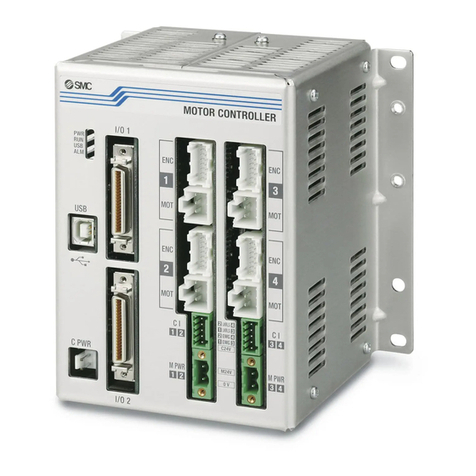
SMC Networks
SMC Networks JXC93 Series Operation manual
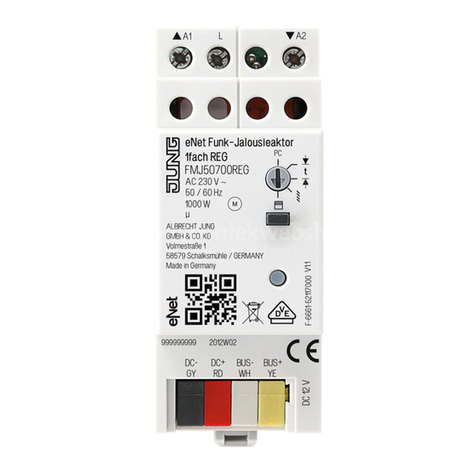
Jung
Jung FM J 50700 REG operating instructions

Siemens
Siemens 540-716 installation instructions
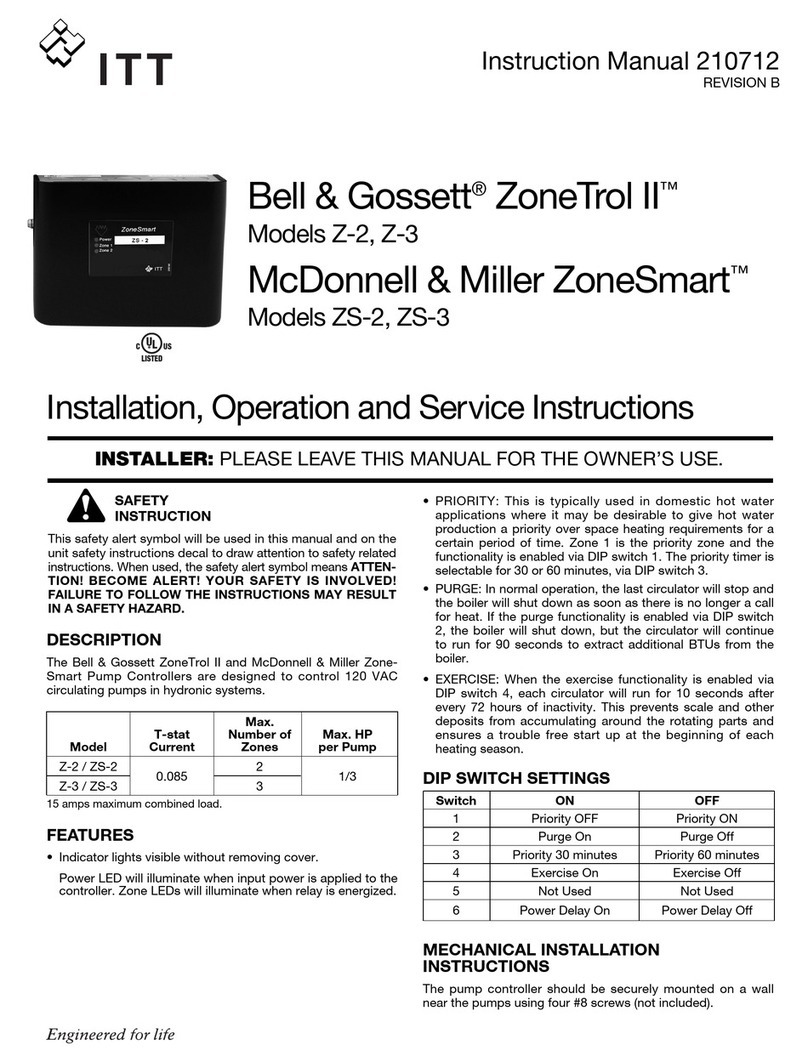
ITT
ITT Bell & Gossett ZoneTrol II Z-2 Installation, operation and service instructions
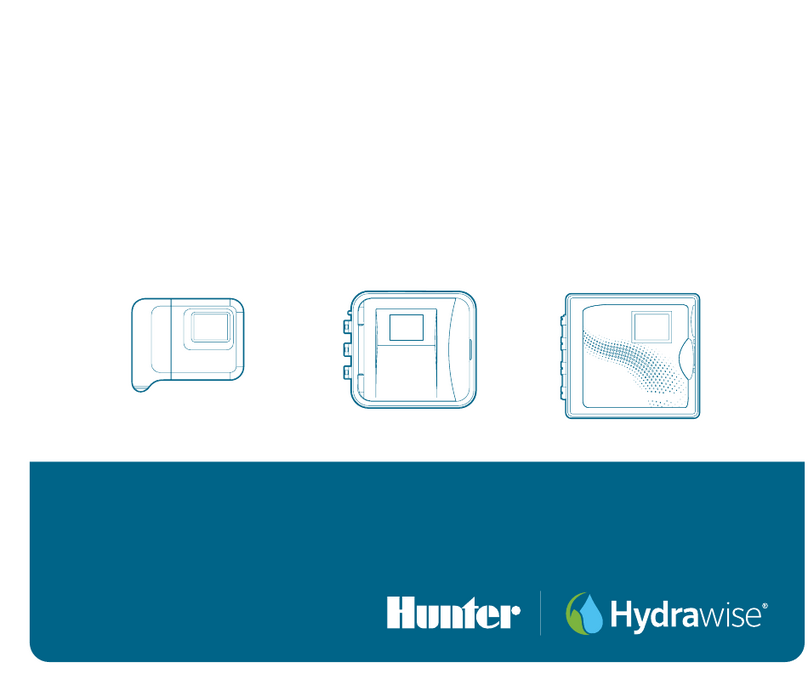
Hunter
Hunter Hydrawise HC-1200M installation guide

